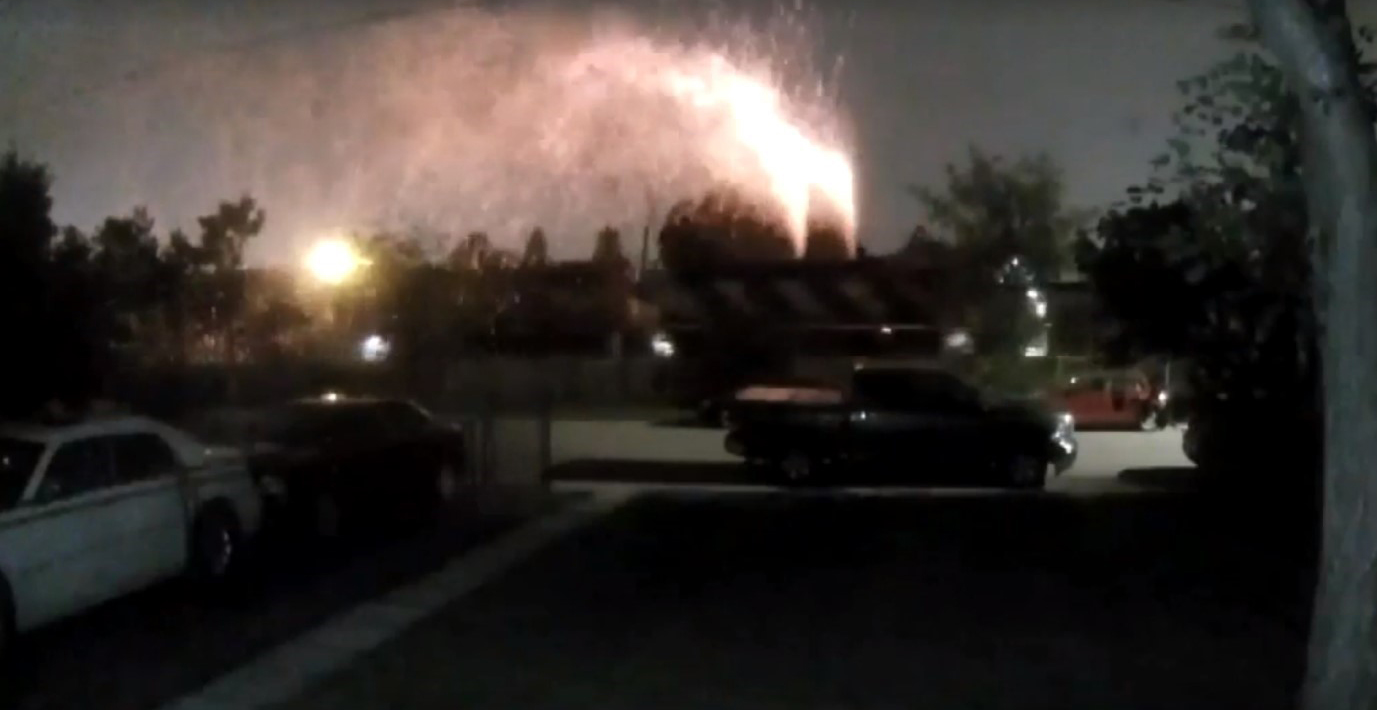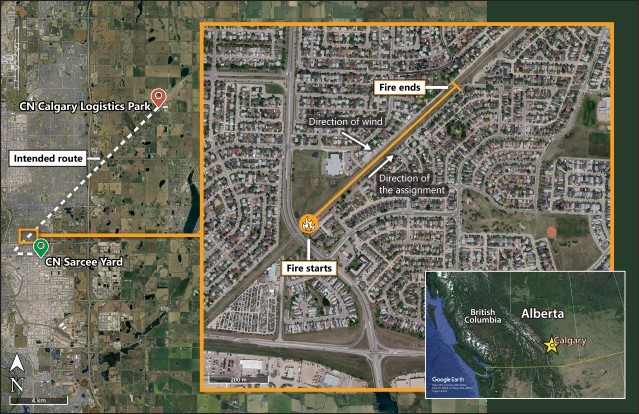Fire on right-of-way
Canadian National Railway Company
Yard assignment YCYS61-16
Mile 124.95, Three Hills Subdivision
Calgary, Alberta
The Transportation Safety Board of Canada (TSB) investigated this occurrence for the purpose of advancing transportation safety. It is not the function of the Board to assign fault or determine civil or criminal liability. This report is not created for use in the context of legal, disciplinary or other proceedings. See Ownership and use of content. Masculine pronouns and position titles may be used to signify all genders to comply with the Canadian Transportation Accident Investigation and Safety Board Act (S.C. 1989, c. 3).
The occurrence
On 17 July 2021, Canadian National Railway Company (CN) remote control locomotive system (RCLS)Footnote 1 yard assignment YCYS61-16, consisting of 2 locomotives and 37 loaded rail cars, was proceeding north on the CN Three Hills Subdivision, from CN Sarcee Yard (Mile 126) in CalgaryFootnote 2 toward the CN Calgary Logistics Park (Mile 114.6). At approximately 0149,Footnote 3 the assignment was travelling at 10 mph near Mile 124.95 when the crew noticed that the lead locomotive (CN 7524) was emitting flames and embers from the exhaust stacks (Figure 1). Some embers migrated to the right-of-way, igniting grass fires. The rail traffic controller was notified, and the Calgary fire department was dispatched.
The fires were extinguished by 0900. There were no dangerous goods involved, and the track did not sustain structural damage. No one was injured.
It was later determined that the grass fires extended along the right-of-way for approximately 2376 feet, from 36 Street SE to Erin Mount Crescent pedestrian crossing (Figure 2). They were contained between the track and a wire fence on the east side of the track.
Weather information
At the time of the occurrence, the temperature was 15 °C, with a northwest wind ranging from 9 to 19 km/h. The relative humidity was around 70%. In the week before the occurrence, the daytime high temperature had ranged from 25 °C to 30 °C.
Crew information
As is common for crews operating RCLS assignments, the crew consisted of 2 conductors, who were both in the cab of the locomotive. The crew members were qualified for their respective positions and met established fitness and rest requirements.
Subdivision information
The Three Hills Subdivision runs north to south between Mirror (Mile 0.0) and the CN Sarcee Yard (Mile 126). It services traffic between Calgary and Edmonton.
Train traffic is governed by the occupancy control system between Mile 3 and Mile 124, as authorized by the Transport Canada (TC)–approved Canadian Rail Operating Rules. All movements are dispatched by a rail traffic controller located in Edmonton.
Sarcee Yard
The CN Sarcee Yard is in an industrial area of southeast Calgary. It is a small satellite yard used mainly to switch cars and make up trains. Yard assignments service the industrial areas around the yard and throughout Calgary, including the CN Calgary Logistics Park. There are commercial and industrial properties adjacent to the yard, with residential property to the north.
The yard has few mechanical personnel on site and minimal maintenance facilities. The locomotives operating in yard assignments at Sarcee Yard remain in Calgary and are inspected and maintained by a mobile repair team until major repairs are required, at which point they are moved to a CN repair facility in a larger yard, usually in Edmonton.
In Sarcee Yard, locomotives are often kept idling as their crews may not be able to troubleshoot issues if they have difficulty restarting a locomotive.
Locomotive CN 7524
Locomotive CN 7524 was a GP38-2 2000 hp locomotive manufactured by General Motors’ Electro-Motive Division in 1972. This type of locomotive is powered by a 16-cylinder, 4-stroke diesel engine equipped with a supercharger.
Supercharged diesel engines
The operation of a diesel engine requires a continuous delivery of air, fuel, coolant, and lubricating oil. The 4 strokes, which relate to the movement of the piston in each cylinder, are as follows: intake, compression, combustion, and exhaust.
During the compression stroke, atomized fuel is injected at a precise time to result in combustion, forcing the piston down and the crankshaft to rotate. The amount of fuel injected depends on the throttle position and load demand. In a supercharged engine, a compressor, driven mechanically from the engine’s crankshaft, increases air pressure in the cylinders to produce more power during combustion. Locomotives equipped with supercharged engines have spark arrestors to prevent the emission of flammable debris from the engine. The spark arrestor is located between the exhaust manifold and the exhaust stack. It diverts any debris in the exhaust downward and captures this debris in a trap. The trap can be accessed by maintenance personnel and cleaned without removing the spark arrestor.
The diesel engine on locomotive CN 7524 is equipped with 16 power assemblies, 8 on each side. The power assemblies include mechanical components that open and close the intake and exhaust valves; these valves regulate the addition of fuel and air delivered to the cylinders and expel exhaust gases during each combustion cycle.
Components inside each power assembly include cylinder liners, pistons, fuel injector nozzles, pushrods, rocker arms, valves, and springs. Failure of key parts within the power assembly can disrupt the combustion cycle, resulting in incomplete compression and combustion of fuel.
Carbon deposit buildup in the exhaust system
Under certain circumstances, for instance when locomotives are left idling for extended periods or when there is incomplete combustion of fuel, carbon deposit can build up in the exhaust system. When this buildup is excessive, it can ignite under high power settings, creating a risk of fire.
Regulatory requirements regarding carbon deposit buildup
With respect to carbon deposit buildup, the TC–approved Railway Locomotive Inspection and Safety Rules state the following:
Locomotives operated in service during the fire season, shall have exhaust passages on the discharge side of spark arresting devices or turbo-chargers kept free of oil accumulation and carbonaceous deposits in excess of ⅛ inch (3 mm) in thickness.Footnote 4
Fire season is defined as the period of time from 01 April to 31 October.Footnote 5
Canadian National instructions on handling locomotives that have been idling for an extended period
To reduce the risks associated with carbon buildup in a locomotive exhaust system, CN’s Locomotive Engineer Operating Manual – Form 8960 provides instructions on handling locomotives that have been idling for an extended period. It states, in part:
When handling non–turbocharged locomotives or consists that have been idling in excess of 3 hours or [for an] unknown period of time, the locomotive or consist must be revved in throttle 6 or 7 for 15 minutes or until exhaust clears before proceeding with work.Footnote 6
Locomotive auto-start function
Locomotives are often equipped with a smart-start function that automatically shuts off and restarts the engine of an idling locomotive when certain conditions are met, for instance if the engine oil temperature or the ambient temperature reaches a given value. The smart-start function keeps locomotives from idling for extended periods, which both conserves fuel and prevents pollution. Locomotive CN 7524 was equipped with a smart-start function; however, the function was disabled because the locomotive had weak batteries and restarting the engine may have been difficult if it were shut down.
Recorded information
The lead locomotive was equipped with a locomotive event recorder (LER). A review of the data revealed no train handling anomalies.
The LER data showed that, when the occurrence crew began their shift at 2141 on 16 July 2021, the locomotive had been idling in Sarcee Yard since 2145 the previous day. In the movements preceding the occurrence, the throttle modulations were frequent, and the throttle positions were held only for short periods, contrary to CN instructions on handling locomotives that have been idling for an extended period. During the occurrence movement, the throttle was placed in position 8 for about 3 minutes, at which time the flames were noticed. This was the first time that a high throttle position was held for more than a few seconds.
Inspection and maintenance of locomotive CN 7524
The last major maintenance of locomotive CN 7524 before the occurrence was conducted from 12 June to 17 June 2021, at CN’s shop in Edmonton. As part of this maintenance, the locomotive underwent electrical and mechanical inspections. Actionable defects identified during these inspections were repaired before the locomotive returned to service at Sarcee Yard; however, the weak batteries were not replaced.
Locomotive safety inspectionsFootnote 7 were performed on 3 occasions in Calgary after the locomotive returned to service: on 29 June, 02 July, and 06 July.
At the time of the occurrence, CN was inspecting the exhaust system at least every 30 days on locomotives equipped with supercharged engines. The spark arrestor on the locomotive was visually inspected in Calgary on 08 July and 12 July 2021, with no anomalies noted.
Post-occurrence inspection of locomotive CN 7524
After the occurrence, locomotive CN 7524 was transferred from Calgary to CN’s locomotive shop in Edmonton for inspection.
A teardown of the locomotive’s exhaust system was performed on 23 and 24 July 2021, with a TSB investigator present. The thickness of the carbon deposits in the exhaust stack was measured and determined to be less than ⅛ inch thick.
Compression testing was also performed by CN on all power assemblies, and the result indicated that the No. 11 power assembly had no compression and the No. 3 power assembly had low compression. As diesel engines rely on compression to create heat and to ignite the diesel fuel, the diesel fuel injected into the No. 11 power assembly and possibly the No. 3 power assembly was not igniting. As a result, during the exhaust cycle, unburned diesel fuel was being expelled into the exhaust system. Once in the exhaust system, the diesel fuel ignited, causing a fire in the locomotive exhaust stack.
Unburned fuel can result in a buildup of carbon deposits in the exhaust system. It is likely that some of the carbon deposits present at the time of the occurrence ignited, creating embers that were expelled from the locomotive exhaust stack before the flames were noticed by the crew. Embers migrated to the right-of-way, igniting grass fires.
The 2 power assemblies were replaced. No further examination was performed on the failed power assemblies to determine the cause of the failure.
Safety action taken
In response to this occurrence and other recent occurrences involving fires on a railway right-of-way, TC approved the new Railway Extreme Heat and Fire Risk Mitigation Rules, which came into effect on 15 June 2022. The new rules stipulate requirements to address track integrity during periods of extreme heat, for inspection of the exhaust system, and for a fire risk mitigation plan for the prevention of fires on railway rights-of-way.
Safety message
At the beginning of the shift, the locomotive engine had been idling for 24 hours. Before proceeding with work, the locomotive was not revved in throttle position 6 or 7 for sufficient time to clear any accumulated carbon deposits from the exhaust system, contrary to CN instructions. Revving the engine can provide train crews with the opportunity to clear the exhaust stack in a controlled setting and detect excessive embers that could indicate abnormal engine function. Therefore, it is important for crews to follow instructions for clearing carbon deposits in the exhaust system on locomotives that have been idling for an extended period.
This report concludes the Transportation Safety Board of Canada’s investigation into this occurrence. The Board authorized the release of this report on . It was officially released on .

